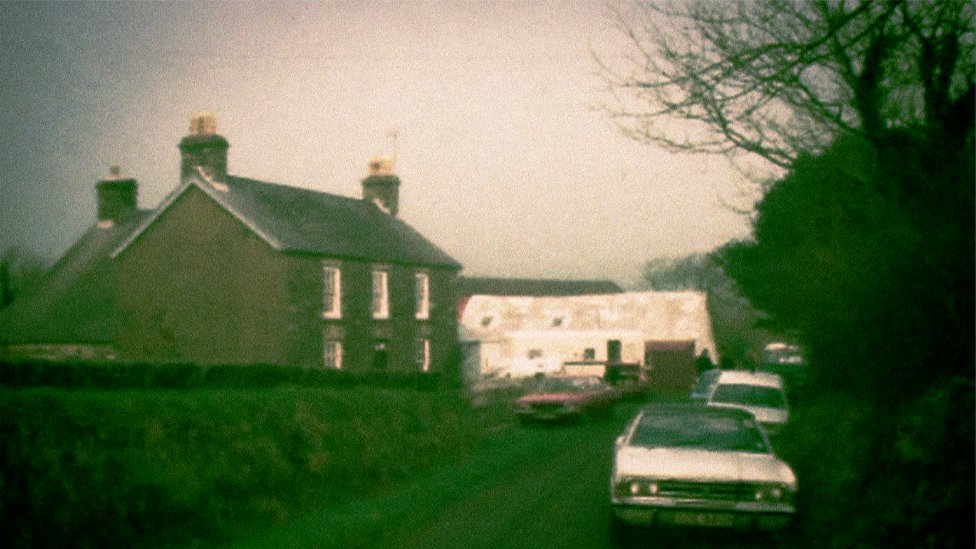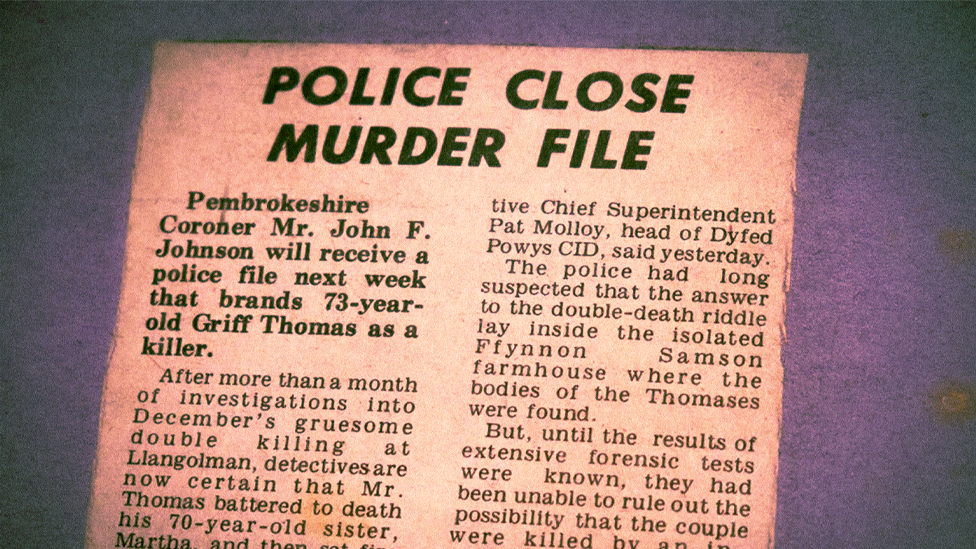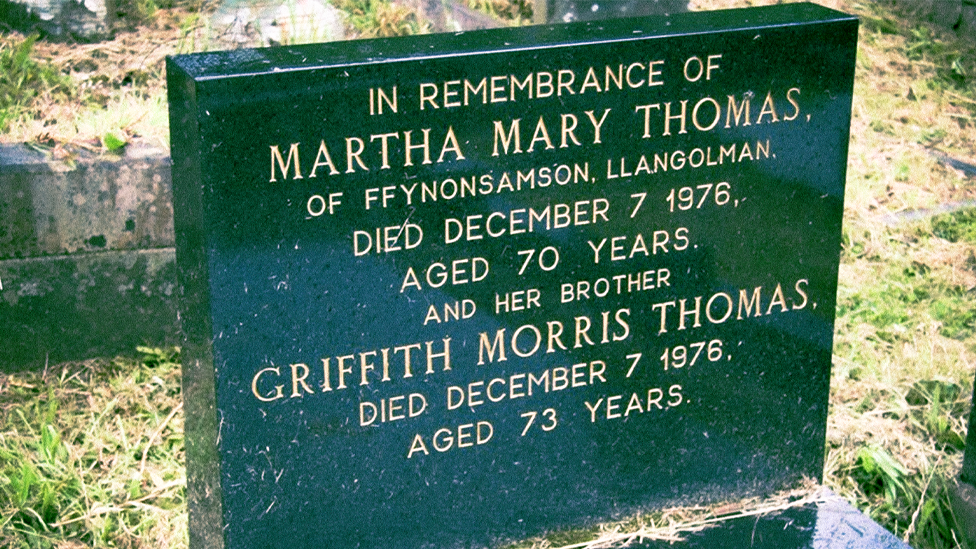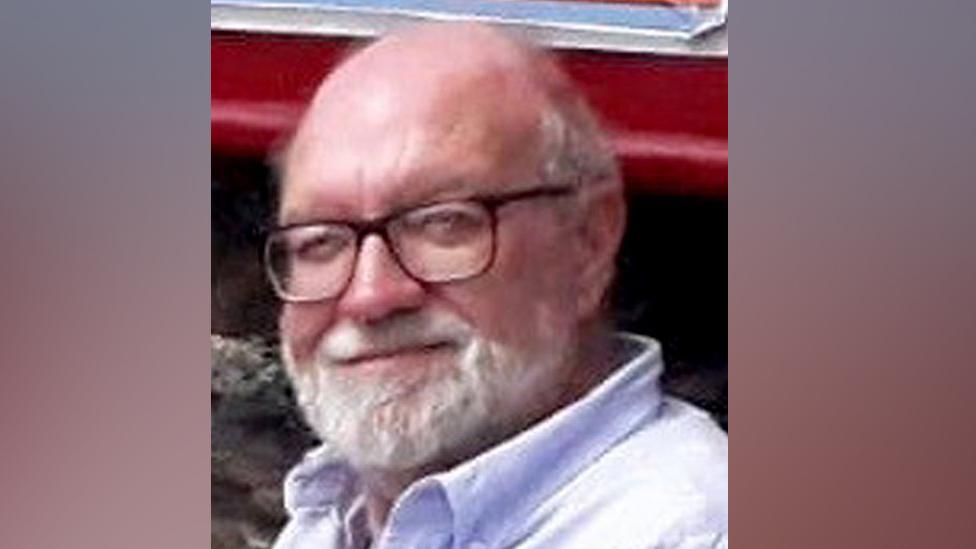Did chapel-goer murder his sister 50 years ago?
The mystery surrounding the deaths of Griff and Patti Thomas
- Published
On a chilly Saturday morning in December 1976, postman Nigel Rossiter pulled up outside an isolated farmhouse in west Wales.
It was his first week in the job and he spotted a couple of letters still lying on the floor of the porch, where he had delivered them days before.
Smelling burning inside, he raised the alarm. This led to the discovery of two bodies – a man who was badly burnt, and his sister, who had severe injuries.
Almost 50 years on, with family challenging the official version of events, Dyfed-Powys Police is now undertaking a forensic review to see if the case should be re-opened.
How a DNA-first caught a serial killer 30 years on
- Published15 May 2023
The 30-year mystery over couple's brutal murder
- Published23 July 2023
Family hope to find son missing for 19 years
- Published1 July 2023
Describing what happened, Nigel, who was then 19, said: "I started shouting 'hello, anybody here?'
"As I opened the door, I could smell burning, smokiness, coming from the chimney, I thought."
It was then he saw the badly-burnt body of 73-year-old Griff Thomas, lying in a pile of charred debris on the kitchen floor.
Officers arrived, and moving further into the house, they discovered a second brutal scene.

Crime Next Door: Death on the Farm
A community fights for justice almost 50 years after the grim discovery of two bodies in a remote farmhouse.
The body of Griff's sister Martha Mary - known as Patti - lay slumped on a magazine rack in the corner of the living room, with severe head injuries.
Chairs had been knocked over and an overturned television lay at Patti's feet. It was still switched on, with the sound of static filling the room.
Patti, who was 70, had been battered to death. Ffynon Samson farmhouse, a half mile outside the village of Llangolman in eastern Pembrokeshire, was now a murder scene.

The bodies of Griff and Patti Thomas were found at the isolated farmhouse where they lived
Just over a month later, detectives reached their conclusion - Griff had "probably" killed his sister in a fit of rage after arguing about money.
But nearly 50 years on, surviving family, friends and neighbours of the siblings still struggle to make sense of the police's version of events.
"There's no way Griff could have smashed the furniture," said Huw Absalom, whose father was Griff and Patti's cousin.
"He would have been unable to cause that damage to Patti. Griff has gone to his grave branded the murderer of his own sister, the one person he lived with all his life, who's been a part of his life through thick and thin.
"It's not fair and it's not right."
After calls for the case to be re-opened, Dyfed-Powys Police announced in October 2022 that it would undertake a forensic review of material gathered by police at the time, to see if modern techniques could "shed further light" on what happened.
That review, dubbed Operation Hallam, is still ongoing and a new BBC podcast, called Death on the Farm, is now exploring the 50-year-old case.
Mr Absalom said he had asked the review team to consider exhuming the bodies, so they can be examined in light of modern forensic techniques.
"Forensics has moved on so much since the 70s, I'm sure they'd be able to look at them now in a new light," he said.
In December 1976, as news of the tragedy spread around the close-knit community, Dyfed-Powys Police launched a double murder investigation and set up an incident room in the heart of the village.
The case was led by a celebrated detective who had solved the notorious Cannock Chase murders, Det Ch Supt Pat Molloy.
More than 1,200 people were spoken to, with police officers knocking on doors over a five-mile radius.
Over the coming weeks, 572 men provided alibis to police that ruled them out of the investigation. But as Christmas came and went, and the new year arrived, no leads were emerging.
So the focus of the inquiry shifted.
By late January 1977, Det Ch Supt Molloy reached his conclusion. He announced that Griff had "probably" killed his sister - possibly by hitting her over the head with a kitchen chair - before starting a fire in which he lay down and died.
For those who had known the siblings throughout their lives, this scenario was incomprehensible.
Mr Absalom, who grew up nearby and was 15 at the time, remembers their deaths sending a "shockwave" through the community.
"I never heard of any falling-out between them, not even a mild argument," he said. "These were God-fearing people, chapel was everything to them."
The siblings were respected and liked in the community and were active members of nearby Rhydwilym Chapel.
Both had lived at Ffynon Samson with their elderly father until his death in 1967. They continued running the farm into the 1970s before retiring and renting land out.

Police at the time concluded that Griff killed his sister Patti, and closed the case just 10 weeks later
Anne Gibby, whose father Emlyn was also a cousin of the siblings and saw the gruesome scene, said: "From what my father said about the scene, he felt it was physically impossible that he had done it.
"It stayed with him all his life and he talked about it until his dying day, that there was no way Griff had done it."
It is a view with which many in the community agree. They point to details about the case which many feel cast doubt on Det Ch Supt Molloy's conclusions.
Did Griff Thomas really kill Patti?
Griff was last seen at the local shop, Charing Cross, on the afternoon of Tuesday, 7 December, and it is believed that he and Patti died that evening.
Two half-drunk cups of tea, and a plate of bread and butter and crisps were found in the living-room - fuelling speculation that someone else had visited the house that evening.
The cheese and newspaper Griff bought at the shop were still in the pocket of the jacket he was wearing when he died.
A large quantity of Griff's blood was found inside Patti's sewing machine, with the cover replaced - part of a left thumbprint found in blood on the cover was never identified.
Their sheepdog, known to bark when anyone visited the farm, had disappeared and locals said it was found drowned in the farmyard well - though this is not referenced in the police report.
Perhaps most significantly, there was lingering doubt over whether frail, arthritic Griff, who used a stick around the farm, suffered with curvature of the spine and had "clawlike" hands affecting his dexterity, would have been physically capable of doing what he was accused of.
"Sitting next to Griff in chapel, he often wouldn't be able to find the page in the hymnbook, because of his hands [so] I'd help him," said Mr Absalom.
"One time he dropped his glasses and couldn't grasp them to pick them up.
"The way she was killed, she was bludgeoned beyond recognition, there's no way he could have done that, physically or mentally. Looking through the evidence, it just doesn't add up."

Patti, when she was younger, and Griff in the late 1970s, had lived together all their lives
In his report, Det Ch Supt Molloy dismissed the likelihood of a third party killing the siblings as "so remote as to be discounted".
But he acknowledged too that there was nothing in their backgrounds to make sense of such an act of violence.
Many believe that Griff disturbed an intruder attacking Patti when he arrived home from the shop - possibly someone they knew demanding money from them.
They were known to be comfortably off - more than £2,000 in cash was found in the farmhouse after their deaths and they left £35,000 in savings and investments.
On 17 February 1977, a jury inquest in Haverfordwest returned verdicts of unlawful killing for Patti Thomas, and an open verdict on Griff.
Just 10 weeks on from their deaths, the case was closed.
Campaign to clear Griff Thomas' name
But over the decades, calls to clear Griff's name have grown, including through a campaign run by community newspaper Clebran.
Its editor, Hefin Wyn, said: "Many were convinced someone else, a third party, was involved in the deaths but people had no influence or authority to challenge the police version of events.
"People were more accepting of authority back then.
"The Thomases were highly regarded in the community. Pat Molloy tried to suggest they were reclusive and constantly bickering, but that isn't borne out by the facts."

Det Ch Supt Pat Malloy, seen here second from left, led the investigation
Denzil Davies, who sometimes worked at Ffynon Samson farm as a teenager, said: "Police said they'd interviewed everyone during their inquiry, but I wasn't interviewed and nor were my friends.
"If this verdict was being judged today, the community would have stood up and said 'no way, you need to look deeper'.
"But even though no-one agreed with them, we'd never have challenged them."
Griff and Patti Thomas are laid to rest together in the graveyard at Rhydwilym Chapel, overlooking the lush valley and River Cleddau where they were baptised.

Griff and Patti Thomas are buried together at the chapel where they worshipped
For Huw Absalom, the campaign to clear Griff's name goes on.
But he accepts that chances of uncovering the truth of what happened at Ffynon Samson may be ebbing away.
"Time is not on our side. It's coming up to 50 years since all this happened, and the number of people who knew them is dwindling every year," he said.
"To walk up to my parents' grave, I have to walk past Griff and Patti's grave.
"Every time, I go over and speak to them and say that I'm still fighting the cause."
Dyfed-Powys Police said in a statement that the forensic review of the case was looking at evidence gathered from the original inquiry in light of modern forensic techniques, to assess whether new evidence could be gathered.
A spokesperson said: "The timeframe for conclusion of the review is not known at this stage, however this work is very much ongoing.
"We are in close contact with the family and continue to update them on our progress."
Related topics
Related Internet Links
- Published21 February 2023

- Published24 April 2023

- Published1 August 2023
